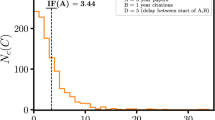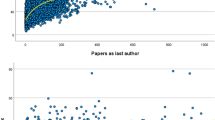Abstract
A new citation index \(h_{\mathrm{PI}}\) for principal investigators (PIs) is defined in analogy to Hirsch’s index h, but based on renormalized citations of a PI’s papers. To this end, the authors of a paper are divided into two groups: PIs and non-PIs. A PI is defined as an assistant, associate or full professor at a university who supervises an individual research program. The citations for each paper of a certain PI are then divided by the number of PIs among the authors of that paper. Data are presented for a sample of 48 PIs of physics and physics-related engineering departments from a private research-oriented U.S. university using the ISI Web of Science citations database. The main result is that individual rankings based on h and \(h_{\mathrm{PI}}\) differ substantially. Also, to a good approximation across the sample of 48 PIs, one finds that \(h_{\mathrm{PI}} = h \,/ \sqrt{<}N_{\mathrm{PI}}{>}\) where \({<}N_{\mathrm{PI}}{>}\) is the average number of principal investigators for the papers of the PI in question. Similarly, \(h_{\mathrm{PI}} = \frac{1}{2} \sqrt{C_{\mathrm{tot}}\,/<N_{\mathrm{PI}}>}\), where \(C_{\mathrm{tot}}\) is the total number of the PI’s citations. Approaches to broadending the scope of h or \(h_{\mathrm{PI}}\) with regard to highly cited papers are compared, and a new metric called \(h_x\) is introduced for such papers which represents the average number of citations exceeding the minimum of \(h^2\) in the h-core. A recent proposal to determine an optimum h-index is also discussed in relationship to actual citation data.











Similar content being viewed by others
References
Alonso, S., Cabrerizo, F. J., Herrera-Viedma, E., & Herrera, F. (2009). h-Index: A review focused in its variants, computation and standardization for different scientific fields. Journal of Informetrics, 3, 273–289.
Batista, P. D., Campiteli, M. G., Kinouchi, O., & Martinez, A. S. (2006). Is it possible to compare researchers with different scientific interests? Scientometrics, 68, 179–189.
Dienes, K. R. (2015). Completing h. Journal of Informetrics, 5, 385–397.
Dorogovtsev, S. N., & Mendes, J. F. F. (2015). Ranking scientists. Nature Physics, 11, 882–883.
Dorta-Gonzalez, P., & Dorta-Gonzalez, M.-I. (2011). Central indexes to the citation distribution: A complement to the h-index. Scientometrics, 88, 729–745.
Eck, N. V., & Waltman, L. (2008). Generalizing the h- and g-indices. Journal of Informetrics, 2, 263–271.
Egghe, L. (2006). Theory and practice of the g-index. Scientometrics, 69, 131–152.
Egghe, L. (2008). Mathematical theory of the h- and g-index in case of fractional counting of authorship. Journal of the American Society for Information Science and Technology, 59, 1608–1616.
Galam, S. (2011). Tailor based allocations for multiple authorship: A fractional gh-index. Scientometrics, 89, 365–379.
Hirsch, J. E. (2005). An index to quantify an individual’s scientific research output. Proceedings of the National Academy of Sciences, 102, 16569–16572.
Hirsch, J. E. (2010). An index to quantify an individual’s scientific research output that takes into account the effect of multiple coauthorship. Scientometrics, 85, 741–754.
Jin, B. H. (2006). h-Index: An evaluation indicator proposed by scientist. Science Focus, 1(1), 8–9. (in Chinese).
Redner, S. (2010). On the meaning of the h-index. Journal of Statistical Mechanics: Theory and Experiment L03005.
Ruscio, J., Seaman, F., D’Oriano, C., Stremlo, E., & Mahalchik, K. (2012). Measuring scholarly impact using modern citation-based indices. Measurement, 10, 123–146.
Schreiber, M. (2010). Twenty Hirsch index variants and other indicators giving more or less preference to highly cited papers. https://arxiv.org/abs/1005.5227.
Schreiber, M. (2008). An empirical investigation of the g-index for 26 physicists in comparison with the h-index, the A-index, and the R-index. Journal of the American Society for Information Science and Technology, 59, 1513–1522.
Schreiber, M. (2009). A case study of the modified Hirsch index \(h_{\mathrm{m}}\) accounting for multiple coauthors. Journal of the American Society for Information Science and Technology, 60, 1274–1282.
Schreiber, M. (2013). A case study of the arbitrariness of the h-index and the highly-cited-publications indicator. Journal of Informetrics, 7, 379–387.
Todeschini, R., & Baccini, A. (2016). Handbook of bibliometric indices: Quantitative tools for studying and evaluating research (pp. 54–73). Hoboken: Wiley.
Tol, R. S. J. (2011). Credit where credit’s due: Accounting for co-authorship in citation counts. Scientometrics, 89, 291–299.
Waltman, L., & van Eck, N. J. (2011). The inconsistency of the h-index. Journal of the American Society for Information Science and Technology, 63, 406–415.
Wu, Q. (2010). The w-index: A measure to assess scientific impact by focusing on widely cited papers. Journal of the American Society for Information Science and Technology, 61, 609–614.
Zhang, C.-T. (2009a). The e-index, complementing the h-index for excess citations. http://journals.plos.org/plosone/article?id=10.1371/journal.pone.0005429.
Zhang, C.-T. (2009b). A proposal for calculating weighted citations based on author rank. EMBO Reports, 10, 416–417.
Author information
Authors and Affiliations
Corresponding author
Rights and permissions
About this article
Cite this article
Steinbrüchel, C. A citation index for principal investigators. Scientometrics 118, 305–320 (2019). https://doi.org/10.1007/s11192-018-2971-8
Received:
Published:
Issue Date:
DOI: https://doi.org/10.1007/s11192-018-2971-8




